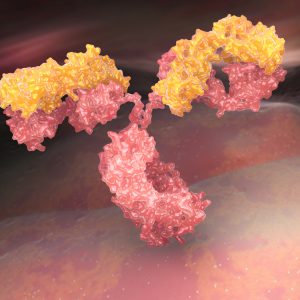Salmonella
Typhoid fever and paratyphoid fever are life-threatening illnesses caused by Salmonella typhi and paratyphi, respectively. Most people in Western countries who contract typhoid fever or paratyphoid fever become infected while traveling abroad, most often to countries where these diseases are common.
The Native Antigen Company offers monoclonal antibodies that can distinguish between Salmonella typhi and paratyphi diseases.
Salmonella Background
The bacterial genus, Salmonella are rod-shaped, gram-negative, facultative anaerobic bacilli, that belong to the family Enterobacteriaceae. The genus is divided into two species groups, Salmonella enterica and Salmonella bongori. S. enterica is further divided into six subspecies which includes S. enterica subspecies enterica. Salmonella typhi is a serovar of this subspecies and is classified as Salmonella enterica serovar typhi. Both S. typhi and S. paratyphi belong to the same subspecies and are generally referred to as Salmonella.
Infection caused by S. typhi or S. paratyphi is generally referred to as typhoid fever. The symptoms caused by S. paratyphi infection are milder than disease caused by S. typhi and include fever, headaches, nausea, loss of appetite, constipation and diarrhoea. In a small percentage of cases, infected individuals may become chronic carriers of S. paratyphi or S. typhi after infection and are responsible for spreading the disease in endemic regions.
Humans are the sole reservoir for S. paratyphi, and the bacterium is transmitted from one person to another through water or food, that has been contaminated with the faeces of an infected individual. S. paratyphi infection is common in developing countries, particularly in densely populated urban areas with poor sanitation and lack of safe drinking water. S. paratyphi primarily invades the gastrointestinal tract and replicates within non-phagocytic epithelial cells and phagocytic cells, thereby evading the immune system (Hurley, D).
Three S. paratyphi serotypes cause paratyphoid fever, which are classified as A, B and C. Paratyphoid fever is symptomatically indistinguishable from typhoid fever, which is caused by S. typhi, and both diseases are referred to as enteric fever. The symptoms of paratyphoid fever are milder than typhoid fever and include fever, headaches, nausea, loss of appetite, constipation, diarrhoea. In a small percentage of cases, infected individuals may become chronic carriers of S. paratyphi after infection, and are responsible for spreading the disease in endemic regions.
Paratyphoid fever, caused by Salmonella enterica serovar paratyphi remains an important public health burden in developing countries and affects travellers visiting countries where S. paratyphi is endemic. Vaccines are not currently available to protect individuals against paratyphoid fever, but licensed vaccines for typhoid fever may provide limited protection (WHO).
References
- Hurley D, McCusker MP, Fanning S, Martins M. (2014). Salmonella-host interactions – modulation of the host innate immune system. Front Immunol. Oct 7;5:481.
- World health organization: Typhoid
Salmonella Antigens
We offer two Salmonella typhi antigens for Hemolysin E and the outer membrane protein (OMP).
Salmonella Antibodies
We offer two monoclonal antibodies specific to Salmonella spp., one which is specific for S. typhi and one specific to S. paratyphi.
Questions?
Check out our FAQ section for answers to the most frequently asked questions about our website and company.



